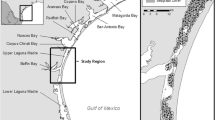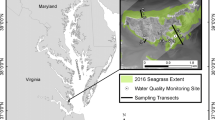Abstract
We evaluate if the distribution and abundance ofThalassia testudinum, Syringodium filiforme, andHalodule wrightii within Biscayne Bay, Florida, are influenced by salinity regimes using, a combination of field surveys, salinity exposure experiments, and a seagrass simulation model. Surveys conducted in June 2001 revealed that whileT. testudinum is found throughout Biscayne Bay (84% of sites surveyed),S. filiforme andH wrightii have distributions limited mainly to the Key Biscayne area.H. wrightii can also be found in areas influenced by canal discharge. The exposure of seagrasses to short-term salinity pulses (14 d, 5–45‰) within microcosms showed species-specific susceptibility to the salinity treatments. Maximum growth rates forT testudinum were observed near oceanic salinity values (30–40‰) and lowest growth rates at extreme values (5‰ and 45‰).S. filiforme was the most susceptible seagrass species; maximum growth rates for this species were observed at 25‰ and dropped dramatically at higher and lower salinity.H. wrightii was the most tolerant, growing well at all salinity levels. Establishing the relationship between seagrass abundance and distribution and salinity is especially relevant in South Florida where freshwater deliveries into coastal bays are influenced by water management practices. The seagrass model developed by Fong and Harwell (1994) and modified here to include a shortterm salinity response function suggests that freshwater inputs and associated decreases in salinity in nearshore areas influence the distribution and growth of single species as well as modify competitive interactions so that species replacements may occur. Our simulations indicate that although growth rates ofT. testudinum decrease when salinity is lowered, this species can still be a dominant component of nearshore communities as confirmed by our surveys. Only when mean salinity values are drastically lowered in a hypothetical restoration scenario isH. wrightii able to outcompeteT. testudinum.
Similar content being viewed by others
Literature Cited
Alleman, R. W. 1995. An update to the surface water improvement and management plan for Biscayne Bay. South Florida Water Management District, West Palm Beach, Florida.
Ault, J., G. A. Diaz, S. G. Smith, J. Luo, andJ. E. Serafy. 1999b. An efficient sampling survey design to estimate pink shrimp population abundance in Biscayne Bay, Florida.North American Journal of Fisheries Management 19:696–712.
Ault, J., J. Luo, S. G. Smith, J. E. Serafy, J. D. Wang, R. Humston, andG. A. Diaz. 1999a. A spatial dynamic multistock production model.Canadian Journal of Fisheries and Aquatic Science 56:4–25.
Brand, L. E. 2002. The transport of terrestrial nutrients to South Florida coastal waters, p. 361–413.In J. W. Porter and K. G. Porter (eds.), The Everglades, Florida Bay, and Coral Reefs of the Florida Keys. An Ecosystem Sourcebook. CRC Press, Boca Raton, Florida.
Brook, I. M. 1982. The effect of freshwater canal discharge on the stability of two seagrass benthic communities in Biscayne National Park, Florida. Proceedings of the International Symposium on Coastal Lagoons, Bordeaux, France.Oceanol Acta 1982:63–72.
Browder, J. A. andJ. C. Ogden. 1999. The natural South Florida system II: Predrainage ecology.Urban Ecosystems 3:245–277.
Browder, J. A. andH. R. Wanless. 2001. Science survey team final report, p. 65–230.In Biscayne Bay Partnership Initiative. Survey Team Final Reports. Biscayne Bay Partnership Initiative, Miami, Florida.
CERP (Comprehensive Everglades Restoration Plan). 2001. Baseline Report for the Comprehensive Everglades Restoration Plan. South Florida Water Management District, West Plam Beach, Florida.
Chin Fatt, J. andJ. D. Wang. 1987. Canal discharge impacts on Biscayne Bay salinities, Biscayne National Park. National Park Service, Southeast Regional Office, Natural Science and Research Division, Atlanta, Georgia.
Conover, J. T. 1964. The ecology, seasonal periodicity, and distribution of benthic plants in some Texas lagoons.Botanica Marina 8:4–21.
Cropper, Jr.,W. P., D. Lirman, S. C. Tosini, D. Diresta, J. Luo, andJ. Wang. 2001. Sponge population dynamics in Biscayne Bay, Florida.Estuarine, Coastal and Shelf Science 53:13–23.
Davis, G. E. andJ. W. Dodrill. 1989. Recreational fishery and population dynamics of spiny lobsters,Panulirus argus, in Florida Bay, Everglades National Park, Florida.Bulletin of Marine Science 44:78–88.
Davis, S. M. andJ. C. Ogden. 1994. Toward ecosystem restoration, p. 769–797.In S. M. Davis and J. C. Ogden (eds.). Everglades. The Ecosystem and its Restoration. St. Lucie Press, Delray Beach, Florida.
De Sylva, D. P. 1969. Sport fisheries, p. 31–34.In G. L. Voss, F. M. Bayer, C. R. Robins, M. F. Gomon, and E. T. LaRoe (eds.), The Marine Ecology of the Biscayne National Monument Miami. Institute of Marine and Atmospheric Sciences, University of Miami, Miami, Florida.
Dunton, K. H. 1990. Production ecology ofRuppia maritima L. s.l. andHalodule wrightii Aschers in two subtropical estuaries.Journal of Experimental Marine Biology and Ecology 143:147–164.
Dunton, K. H. 1994. Seasonal growth and biomass of the subtropical seagrassHalodule wrightii in relation to continuous measurements of underwater irradiance.Marine Biology 120: 479–489.
Fong, P. andM. A. Harwell. 1994. Modeling seagrass communities in tropical and subtropical bays and estuaries: A mathematical model synthesis of current hypotheses.Bulletin of Marine Science 54:757–781.
Fong, P., M. E. Jacobson, M. C. Mescher, D. Lirman, andM. C. Harwell. 1997. Investigating the management potential of a seagrass model through sensitivity analysis and experiments.Ecological Applications 7:300–315.
Fourqurean, J. W., M. J. Durako, M. O. Hall, andL. N. Hefty. 2002. Seagrass distribution in South Florida: A multi-agency coordinated monitoring program, p. 497–522.In J. W. Porter and K. G. Porter (eds.), The Everglades, Florida Bay, and Coral Reefs of the Florida Keys. An Ecosystem Sourcebook. CRC Press, Boca Raton, Florida.
Fourqurean, J. C., G. V. N. Powell, W. J. Kenworthy, andJ. W. Zieman. 1995. The effects of long-term manipulation of nutrient supply on competition between the seagrassesThalassia testudinum andHalodule wrightii in Florida Bay.Oikos 72: 349–358.
Fourqurean, J. W. andM. B. Robblee. 1999. Florida Bay: A brief history of recent ecological changes.Estuaries 22:345–357.
Gallegos, M. E., M. Merino, A. Robriguez, N. Marba, andC. M. Duarte. 1994. Growth patterns and demography of pioneer Caribbean seagrassesHalodule wrightii andSyringodium filiforme.Marine Ecology Progress Series 109:99–104.
Hall, M. O., M. J. Durako, J. W. Fourqurean, andJ. C. Zieman. 1999. Decadal changes in seagrass distribution and abundance in Florida Bay.Estuaries 22:445–459.
Harwell, M. A. 1997. Ecosystem management of South Florida.BioScience 47:499–512.
Holmquist, J. G., G. V. N. Powell, andS. M. Sogard. 1989. Decapod and stomatopod assemblages on a system of seagrass-covered mud banks in Florida Bay.Marine Biology 100: 473–483.
Irlandi, E., B. Orlando, S. Macia, P. Biber, T. Jones, L. Kaufman, D. Lirman, andE. Patterson. 2001. The influence of freshwater runoff on biomass, morphometrics, and production ofThalassia Testudinum.Aquatic Botany 1536:1–12.
Lewis, III,R. R., M. J. Durako, andR. C. Phillips. 1985. Seagrass meadows in Tampa Bay—A review, p. 210–246.In S. A. F. Trent, J. L. Simon, R. R. Lewis, III, and R. L. Whitman, Jr. (eds.), Proceedings Tampa Bay Area Scientific Information Symposium. Florida Sea Grant College Report 65. Florida Sea Grant, Gainsville, Florida.
Light, S. S. andJ. W. Dineen. 1994. Water control in the Everglades: A historical perspective, p. 47–84.In S. M. Davis and J. C. Ogden (eds.), Everglades. The Ecosystem and Its Restoration. St. Lucie Press, Delray Beach, Florida.
McMahan, C. A. 1968. Biomass and salinity tolerance of shoalgrass and manateegrass in Lower Laguna Madre, Texas.Journal of Wildlife Management 32:501–506.
McMillan, C. 1974. Salt tolerance of mangroves and submerged aquatic plants, p. 379–390.In R. J. Reimold and W. H. Queen (eds.). Ecology of Halophytes. Academic Press, New York.
McMillan, C. andF. N. Moseley. 1967. Salinity tolerances of five marine spermatophytes of Redfish Bay, Texas.Ecology 48: 503–506.
Montague, C. L. 1989. The distribution and dynamics of submerged vegetation along gradients of salinity in northeast Florida Bay.Bulletin of Marine Science 44:521.
Montague, C. L. andJ. A. Ley. 1993. A possible effect of salinity fluctuation on abundance of benthic vegetation and associated fauna in Northeastern Florida Bay.Estuaries 16:703–717.
Robblee, M. B., T. R. Barber, P. R. Carlson, M. J. Durako, J. W. Fourqurean, L. K. Muehlstein, D. Porter, L. A. Yarbro, R. T. Zieman, andJ. C. Zieman. 1991. Mass mortality of the tropical seagrassThalassia testudinum in Florida Bay (USA).Marine Ecology Progress Series 71:297–299.
Short, F. T., M. W. Davis, R. A. Gibson, andC. F. Zimmerman. 1985. Evidence of phosphorus limitation in carbonate sediments of the seagrassSyringodium filiforme.Estuarine, Coastal and Shelf Science 20:169–174.
Smith, III,T. J., J. H. Hudson, M. B. Robblee, G. V. N. Powell, andP. J. Isdale. 1989. Freshwater flow from the Everglades to Florida Bay: A historical reconstruction based on fluorescent banding in the coralSolenastrea bournoni.Bulletin of Marine Science 44:274–282.
Thorhaug, A. 1976. The vascular plants of Biscayne Bay, p. 95–102.In A. Thorhaug and A. Volke (eds.), Biscayne Bay: Past/present/future. Papers prepared for Biscayne Bay Symposium I. University of Miami Sea Grant College Program, Miami, Florida.
Tomasko, D. A., C. J. Dawes, andM. O. Hall. 1991. Effects of the number of short shoots and presence of the rhizome apical meristem on the survival and growth of transplantedThalassia testudinum.Contributions in Marine Science 32:41–48.
Walker, D. I., K. A. Hillman, G. A. Kendrick, andP. Lavery. 2001. Ecological significance of seagrasses: Assessment for management of environmental impact in Western Australia.Ecological Engineering 16:323–330.
Wang, J. D., E. Daddio, andM. D. Horwitz. 1978. Canal discharges into south Biscayne Bay. Report to Metro Dade Department of Environmental Resources Management. University of Miami, Miami, Florida.
Wang, J. D., J. Luo, and J. Ault. In press. Flows, salinity, and some implications on larval transport in South Biscayne Bay, Florida.Bulletin of Marine Science.
Williams, S. L. 1987. Competition between the seagrassesThalassia testudinum andSyringodium filiforme in a Caribbean lagoon.Marine Ecology Progress Series 35:91–98.
Williams, S. L. 1990. Experimental studies of Caribbean seagrass bed development.Ecological Monographs 60:449–469.
Wortmann, J. J., W. Hearne, andJ. B. Adams. 1997. A mathematical model of an estuarine seagrass.Ecological Modelling 98: 137–149.
Zieman, J. C. 1972. Origin of circular beds ofThalassia (Spermatophyta: Hydrocharitaceae) in south Biscayne Bay, Florida, and their relationship to mangrove hammocks.Bulletin of Marine Science 22:559–574.
Zieman, J. C. 1974. Methods for the study of the growth and production of turtle grass,Thalassia testudinum Konig.Aquaculture 4:139–143.
Zieman, J. C. 1975. Seasonal variation of turtle grass,Thalassia testudinum König, with reference to temperature and salinity.Aquatic Botany 1:107–123.
Zieman, J. C. 1976. The ecological effects of physical damage from motor boats on turtle grass beds in southern Florida.Aquatic Botany 2:127–139.
Zieman, J. C. 1982. The ecology of the seagrasses ofsouth Florida: A community profile. FWS/OBS-82/25. U.S. Fish and Wildlife Services, Office of Biological Services, Washington, D.C.
Zieman, J. C., J. W. Fourqurean, andT. A. Frankovich. 1999. Seagrass die-off in Florida Bay: Long-term trends in abundance and growth of turtle grass,Thalassia testudinum.Estuaries 22:460–470.
Zieman, J. C., J. W. Fourqurean, andR. L. Iverson. 1989. Distribution, abundance and productivity of seagrasses and macroalgae in Florida Bay.Bulletin of Marine Science 44:292–311.
Author information
Authors and Affiliations
Corresponding author
Rights and permissions
About this article
Cite this article
Lirman, D., Cropper, W.P. The influence of salinity on seagrass growth, survivorship, and distribution within Biscayne Bay, Florida: Field, experimental, and modeling studies. Estuaries 26, 131–141 (2003). https://doi.org/10.1007/BF02691700
Received:
Revised:
Accepted:
Issue Date:
DOI: https://doi.org/10.1007/BF02691700




